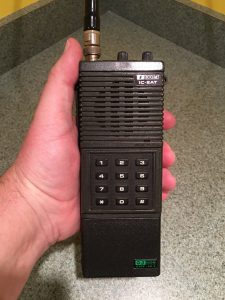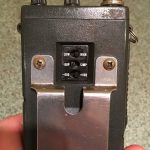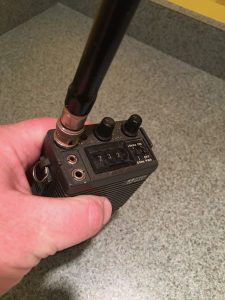
This is the first in a series of short reviews of handheld/portable/HT radios. Read more about the series here.
The Icom IC-2AT
In about 1980, the newest, hottest HT on the market was the Icom IC-2AT. It was fairly revolutionary at the time, and was probably the second fully synthesized 2 meter handheld radio available. The Tempo S1 came before it by about a year, but the Icom IC-2AT was priced lower and became a little more mainstream. Before these radios came out, each frequency required a crystal to be installed. Dual-band radios didn’t exist in the 1980’s, and this 2-meter-only radio was one of the most popular in its day.
By today’s standards, this radio was fairly large, and only had about 1.5 watts RF output. This picture is N8CD’s first handheld – literally this was the exact radio I bought with paper route money and a little help from my parents at the age of 14. It stayed in the family all these years.
The original brochure can be found on WD8RIF’s site: front and back of the brochure
Pros:
- Very good, full bodied receive and transmit audio with its full size speaker and large condenser micrphone
- Easy top operate (no memories, no scan, no priority channels, etc)
- Nice, big BNC connector for the antenna
- Very sturdy case and real metal belt clip.
- Zero surface mounted components and a simple design – easily repairable with standard electronic tools and parts that are still mostly available even in 2018.
Cons:
- Large, and relatively heavy
- Relatively low power output by today’s standards
- No CTCSS encode or decode built-in. Communications Specialists made a small encoder that would barely fit into the radio. The board also had to be pre-set to one CTCSS tone, and it was not possible to change it from the radio without disassembly. In the early 80’s most repeaters did not require a CTCSS (PL) tone, but today this is very necessary.
- No scan, memories, etc. This can be both good and bad.
Setting the frequencies on the radio was done with thumbwheels on the top of the radio. Choosing simplex, + or – offset, and high and low power was done with switches on the back of the radio. 
Conclusion:
While using the Icom IC-2AT brings back memories for me, it’s not really practical these days without CTCSS (PL). If you’re looking for an inexpensive radio to get started, this radio will probably bring you more problems than you’d like because of it’s age. If you are looking for nostalgia, this radio can often be found on the used market for less than $50, but will almost certainly require new batteries. Expect most of the ones on the market to need switches and volume/squelch pots to need cleaned, but with a healthy battery and some TLC the radio is usable if CTCSS flexibility isn’t a requirement for you.

